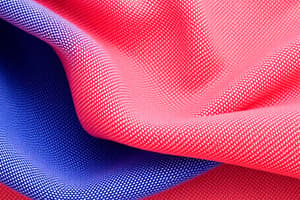Podcast
Questions and Answers
Which type of textile is specifically designed for surgical use?
Which type of textile is specifically designed for surgical use?
- Medical Textiles (correct)
- Technical Textiles
- Automotive Textiles
- Industrial Textiles
What is a primary application of agricultural textiles?
What is a primary application of agricultural textiles?
- Shade nets (correct)
- Surgical implants
- Seat covers
- Fire-resistant clothing
Which textile category includes products designed to minimize environmental impact?
Which textile category includes products designed to minimize environmental impact?
- Transport Textiles
- Technical Textiles
- Eco-Friendly Fabrics (correct)
- Luxury Textiles
What is predominantly used in the fashion industry for everyday wear?
What is predominantly used in the fashion industry for everyday wear?
Which type of textile is used in aerospace applications?
Which type of textile is used in aerospace applications?
Which textiles are specifically designed for military applications?
Which textiles are specifically designed for military applications?
What type of textile includes items like carpets and drapes?
What type of textile includes items like carpets and drapes?
Which textile type encompasses wearable technology?
Which textile type encompasses wearable technology?
What characteristic distinguishes lyocell from rayon?
What characteristic distinguishes lyocell from rayon?
Which regenerated fiber is specifically made from cotton linter?
Which regenerated fiber is specifically made from cotton linter?
Which of the following uses is NOT associated with rayon?
Which of the following uses is NOT associated with rayon?
What is a notable environmental concern regarding regenerated fibers?
What is a notable environmental concern regarding regenerated fibers?
Which of the following is a natural fiber derived from plants?
Which of the following is a natural fiber derived from plants?
What makes modal more durable than rayon?
What makes modal more durable than rayon?
What characteristic distinguishes synthetic fibers such as polyester?
What characteristic distinguishes synthetic fibers such as polyester?
Which of the following textiles is known for its moisture-wicking properties?
Which of the following textiles is known for its moisture-wicking properties?
Which regenerated fiber is known for being the most biodegradable?
Which regenerated fiber is known for being the most biodegradable?
What is the primary difference between weaving and knitting?
What is the primary difference between weaving and knitting?
Which of the following characteristics is NOT true of regenerated fibers?
Which of the following characteristics is NOT true of regenerated fibers?
What is a common use for lyocell fibers?
What is a common use for lyocell fibers?
Which fiber is known to be produced by the chemical processing of natural materials?
Which fiber is known to be produced by the chemical processing of natural materials?
What textile is typically used for high-quality sweaters due to its softness?
What textile is typically used for high-quality sweaters due to its softness?
Which fiber is mainly used in eco-friendly products due to its durability?
Which fiber is mainly used in eco-friendly products due to its durability?
In textile production, which technique involves layering fibers to create a fabric without weaving or knitting?
In textile production, which technique involves layering fibers to create a fabric without weaving or knitting?
What does tensile strength measure in a fiber?
What does tensile strength measure in a fiber?
Which property expresses the amount of stretch a fiber undergoes before it breaks?
Which property expresses the amount of stretch a fiber undergoes before it breaks?
What is another name for the elastic modulus of a fiber?
What is another name for the elastic modulus of a fiber?
What does tenacity measure in fibers?
What does tenacity measure in fibers?
What does the Y-axis of a stress-strain diagram represent?
What does the Y-axis of a stress-strain diagram represent?
Which aspect does the initial modulus of a fiber specifically represent?
Which aspect does the initial modulus of a fiber specifically represent?
How is strain defined in the context of a stress-strain diagram?
How is strain defined in the context of a stress-strain diagram?
Which of the following is NOT a mechanical property of fibers?
Which of the following is NOT a mechanical property of fibers?
What is the primary difference between homopolymers and copolymers?
What is the primary difference between homopolymers and copolymers?
Which of the following best illustrates a homopolymer?
Which of the following best illustrates a homopolymer?
In the context of polymer formation, what role do monomers play?
In the context of polymer formation, what role do monomers play?
Which mechanical properties of fibers are most commonly considered in material selection for textiles?
Which mechanical properties of fibers are most commonly considered in material selection for textiles?
What can be inferred about the stress-strain relationship of different fibers based on the given data?
What can be inferred about the stress-strain relationship of different fibers based on the given data?
What best describes the structure of a copolymer?
What best describes the structure of a copolymer?
How can the mechanical properties of fibers impact their application in the aerospace industry?
How can the mechanical properties of fibers impact their application in the aerospace industry?
Which of the following statements about polymer chains is true?
Which of the following statements about polymer chains is true?
Flashcards are hidden until you start studying
Study Notes
Textile Applications
- Apparel textiles: clothing (everyday wear, fashion, activewear, undergarments), footwear (socks, linings, laces), accessories (scarves, ties, hats, gloves).
- Home textiles: bedding (sheets, pillowcases, blankets), bath (towels, robes, mats), upholstery (sofa covers, cushions), window treatments (curtains, drapes), floor coverings (carpets, rugs), kitchen textiles (tablecloths, napkins), outdoor (patio furniture covers).
- Technical textiles: medical (surgical gowns, bandages, implants), automotive (seat covers, airbags), construction (geotextiles, tarpaulins), agricultural (shade nets, crop covers), protective (fire-resistant clothing, bulletproof vests), sports (performance clothing, equipment covers).
- Industrial textiles: filtration (air and water filters), transport (conveyor belts, safety belts), packaging (sacks, bags).
- Smart textiles: wearable technology (clothing with sensors, temperature regulation), e-textiles (fabrics with embedded electronics).
- Interior textiles: wall coverings (wallpapers), ceilings (acoustic panels), lamps and lighting (textile lampshades).
- Environmental textiles: eco-friendly fabrics (organic cotton, recycled polyester), sustainable textiles (minimal environmental impact).
- Military textiles: camouflage fabrics, ballistic protection (Kevlar vests), tent and shelter fabrics.
- Transport textiles: aerospace (lightweight composites, insulation), marine (sails, boat covers).
- Luxury textiles: high-end fashion (couture fabrics), luxury interiors (designer upholstery).
Fibers: Natural and Man-Made
- Natural fibers: plant-based (cotton, linen, hemp); animal-based (wool, silk, cashmere).
- Man-made fibers: synthetic (polyester, nylon, acrylic); regenerated (rayon/viscose, lyocell/Tencel, modal, cupro). Regenerated fibers are chemically processed from natural materials like cellulose.
Regenerated Fiber Properties
- Advantages: comfort (softness, breathability), versatility (adaptability, wide range of uses), eco-friendliness (renewable sources, biodegradability), aesthetic appeal (drape, feel, dyeability).
- Disadvantages: environmental concerns (chemical processing).
Fiber Mechanical Properties
- Tensile strength: maximum stress before breaking.
- Elongation at break: amount of stretch before breaking.
- Elastic modulus (Young's modulus): stiffness.
- Initial modulus: initial stiffness.
- Tenacity: ultimate tensile strength per unit linear density.
- Stress-strain diagram: graphical representation of a material's response to applied stress, showing deformation under various stress levels. Shows stress (force per unit area) versus strain (deformation).
Polymers and Fiber Surface
- Polymers are long chains of repeating units called monomers.
- Homopolymers: consist of a single type of monomer.
- Copolymers: consist of two or more types of monomers.
Studying That Suits You
Use AI to generate personalized quizzes and flashcards to suit your learning preferences.




